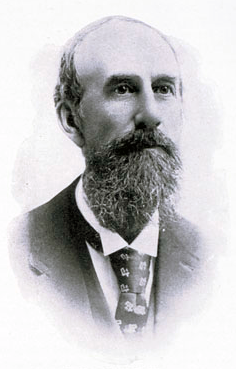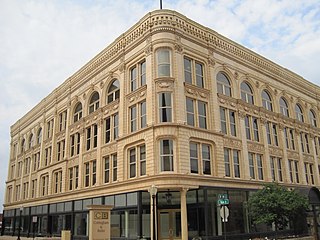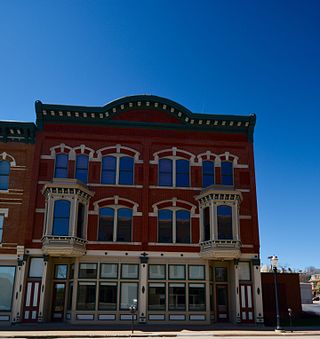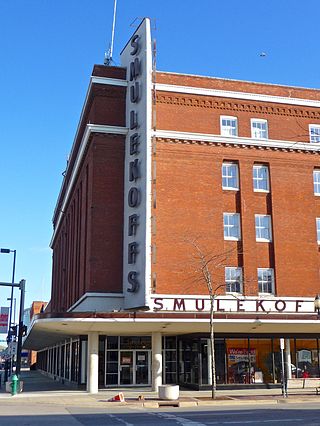
The Walgreen Drug Store is a historic site in Miami, Florida. It is found at 200 East Flagler Street.

This is a list of the National Register of Historic Places listings in Sheboygan County, Wisconsin. It is intended to provide a comprehensive listing of entries in the National Register of Historic Places that are located in Sheboygan County, Wisconsin. The locations of National Register properties for which the latitude and longitude coordinates are included below may be seen in a map.

This is a list of the National Register of Historic Places listings in Pipestone County, Minnesota. It is intended to be a complete list of the properties and districts on the National Register of Historic Places in Pipestone County, Minnesota, United States. The locations of National Register properties and districts for which the latitude and longitude coordinates are included below, may be seen in an online map.

Thomas M. Blackstock was a Scotch-Irish American immigrant, businessman, and Republican politician. He was co-founder and president of the Phoenix Chair Company in Sheboygan, Wisconsin, and served four years as mayor of Sheboygan in the 1870s and 1880s.

Meiser Drug Store is a historic building located in the West End of Davenport, Iowa, United States. It was built in 1888 and listed on the National Register of Historic Places in 1983. Amielius Meiser built this structure to house his drug store. He had previously operated an apothecary across the street, and he lived on the upper floors of both buildings. This building is noteworthy for the brick and metal cornice and the light colored stone used in the details.

Finley Guy Building is a historic building in central Davenport, Iowa, United States. The Spanish Colonial Revival structure was listed on the National Register of Historic Places in 1984.

The Hines Mansion is a historic house in Provo, Utah, United States. It is listed on the National Register of Historic Places. It was built in 1895 for R. Spencer Hines and his wife Kitty. At the time the mansion was built, it was recognized as one of the finest homes in Provo. The Hines Mansion was designated to the Provo City Historic Landmarks Registry on March 7, 1996.

Old Downtown Harrisburg Commercial Historic District is a national historic district located at Harrisburg, Dauphin County, Pennsylvania. The district includes 50 contributing buildings in the old central business district of Harrisburg and dating from the late-19th and early-20th centuries. Notable buildings include the Daily and Weekly Telegraph Building (1873-1874), City Bank Building, F.W. Woolworth (1939), Rothert's Furniture Store (1906), Bowman's Department Store, Pomeroy's Department Store, and Doutrich's Clothing Store. Located in the district and listed separately are the Colonial Theatre, Keystone Building, Kunkel Building, and the William Seel Building. The Telegraph Building was delisted after having been demolished.

Halifax Historic District is a national historic district located at Halifax, Halifax County, North Carolina, US that was listed on the National Register of Historic Places in 1970. It includes several buildings that are individually listed on the National Register. Halifax was the site of the signing of the Halifax Resolves on April 12, 1776, a set of resolutions of the North Carolina Provincial Congress which led to the United States Declaration of Independence gaining the support of North Carolina's delegates to the Second Continental Congress in that year.

West End Commercial Historic District is a national historic district located at Greenville, South Carolina. It encompasses 15 contributing buildings in Greenville's second "downtown." The commercial buildings primarily date from about 1880 to 1920, and include examples of Victorian commercial architecture. Notable buildings include the American Bank, Alliance and Mills & McBayer Cotton Warehouses, Indian River Fruit Store, Pete's Place, Bacot's West End Drug Store/Stringer's Drug, Furman Lunch, and Greer Thompson Building.

Lenoir Downtown Historic District is a national historic district located at Lenoir, Caldwell County, North Carolina. The district includes 41 contributing buildings and 2 contributing objects in the central business district of Lenoir. It includes commercial, governmental, and institutional buildings in a variety of popular architectural styles including Art Deco, Art Moderne, Classical Revival and Tudor Revival. Notable contributing resources include the Center Theater (1941), O. P. Lutz Furniture Company and Lutz Hosiery Mill (1939), Dayvault's Drug Store (1937), Caldwell County Agricultural Building (1937), Courtney Warehouse, Masonic Hall, Miller Building, Confederate Monument (1910), Belk's Department Store (1928), Lenoir Building (1907), J. C. Penney Department Store, Fidelity Building (1928), and U. S. Post Office (1931). Located in the district is the separately listed Caldwell County Courthouse.

The Security Building, also known as the Stampfer Building, is a historic structure in Dubuque, Iowa, United States. The cream-colored building is associated with the J. F. Stampfer Co. department store.

The C.H. King Company and First National Bank Building, also known as Yellowstone Drug, is one of the oldest buildings in Shoshoni, Wyoming. The building was built for Charles Henry King in 1905–1906. King was a central Wyoming businessman who established a lumber business in the building. King is otherwise notable as the biological grandfather of U.S. president Gerald R. Ford. The First National Bank of Shoshoni was also located in the building.

The Ziepprecht Block is a historic building located in Dubuque, Iowa, United States. Completed in 1888, it is a fine example of transitional commercial Italianate architecture. The three-story brick structure features a heavy projecting cornice and rounded pediment from the Italianate, with larger paired windows from the Second Empire style, and three-sided bay windows from the Queen Anne style. It is also one of a small number of double storefront blocks that remain in the downtown area. The building is named for Henry Ziepprecht a German-born druggist who settled in Dubuque in 1856 and died in 1887. His estate paid to have this building constructed on the location of an older building that housed his drug store. Now managed by Joseph Wittmer, the drug store and a confectionery were the first businesses to occupy the storefronts. The upper floors housed apartments. The building was listed on the National Register of Historic Places in 2002.

The Hawthorne Glove and Novelty Company–Shrader Drug Company Building is a historic building located in Iowa City, Iowa, United States. Completed in 1906, this utilitarian three-story brick structure is located in the city's original railroad and industrial corridor south of the central business district. This was an industrial area from the 1870s to the 1940s. It replaced a recently built building on the same site by the Hawthorne Glove and Novelty Company that had been destroyed in a fire. The back of the building opened upon the rail sidings of a branch line of the Burlington, Cedar Rapids and Northern Railway, later the Chicago, Rock Island and Pacific. By the start of World War I the Shrader Drug Company occupied the building. It was one of three drug related factories that were located along the South Gilbert Street corridor at that time. The company name changed to the Hewell-Shrader Drug Company in 1930 and then the Hewell-Shrader Company in 1945 after farm fertilizer was added to its product line. The company closed in 1956, and the building was sold to the Thompson Transfer and Storage Company who used it for a warehouse. Whipple House Furniture Store took over the building three years later, and remained until 1975. In the intervening years a variety of businesses occupied the building until the 1980s when it was vacant for a period of time. In the mid-1980s The Vine Tavern occupied the basement level and the upper floors were used for artist studios. In 2012 the upper floors were converted into apartments. The building was listed on the National Register of Historic Places in 2014.

Smulekoffs Furniture Store, also known as the Sinclair Building, New Sinclair Building, Warfield–Pratt–Howell Co. building and the Churchill Drug Co. building, is a historic building located in Cedar Rapids, Iowa, United States. In 1901 Thomas Sinclair had the original section of this five-story brick structure built. It housed the wholesale grocer Warfield–Pratt–Howell Co. and another wholesaler, the Churchill Drug Co. It was the second of several large-scale warehouse buildings that were constructed in this section of the city along the Cedar River. A spur line of the Chicago, Milwaukee, St. Paul and Pacific Railroad was located at the rear of the building. Rosenbaum Furniture Store bought the building in 1925, and it was converted from warehouse use to retail. In 1941 Smulekoffs Furniture Store took over the building and renovated the main floor. They remained here until 2014. The building is slated for apartments on the upper floors and retail on the main floor. It was listed on the National Register of Historic Places in 2016.

The Belle Fourche Commercial Historic District, a 8 acres (3.2 ha) historic district in Belle Fourche, South Dakota, was listed on the National Register of Historic Places in 1982.

The Farmers and Mechanics Bank is a historic building in the Georgetown neighborhood of Washington, D.C. Constructed between 1921 and 1922, the bank was first the headquarters of the Farmers and Mechanics National Bank. Soon thereafter, it became known as the Farmers and Mechanics Branch of Riggs National Bank. In 2005, the building became a branch of PNC bank.

Thomas Drugs is a drug store located in Cross Plains, Tennessee. The building was constructed in 1915 and operated as a General Store, until it was purchased by the Thomas Family. The pharmacy opened in 1930. In 1976, the store was purchased by Dan Green. In January 1991, Thomas Drugs began to serve food items at the Soda Fountain. Thomas Drugs has been listed on the National Register of Historic Places since November 4, 1993.

The Peruna Drug Manufacturing Company Building was a historic building in Downtown Columbus, Ohio. It was built c. 1902 and was listed on the National Register of Historic Places in March 1973. The building was demolished in November 1973.





















